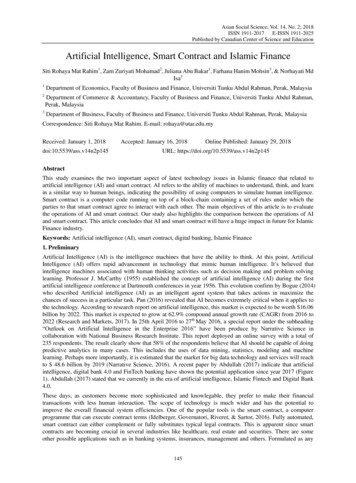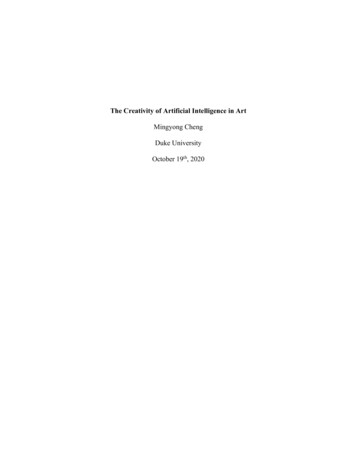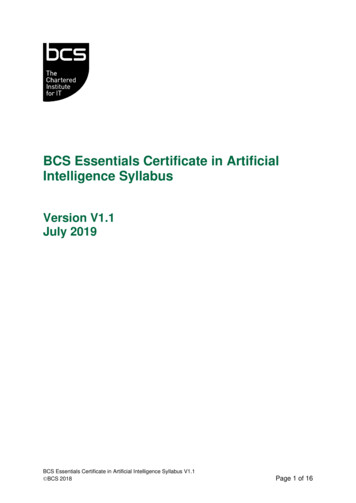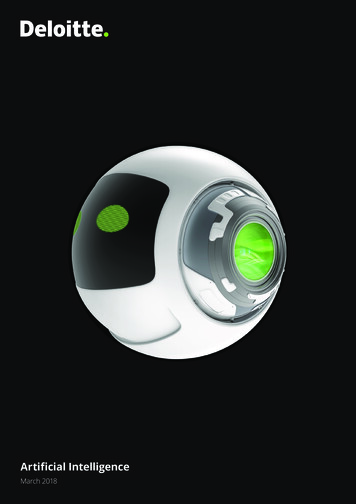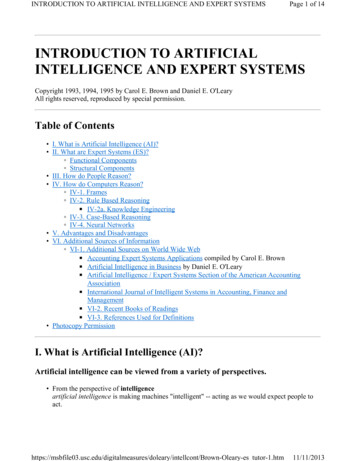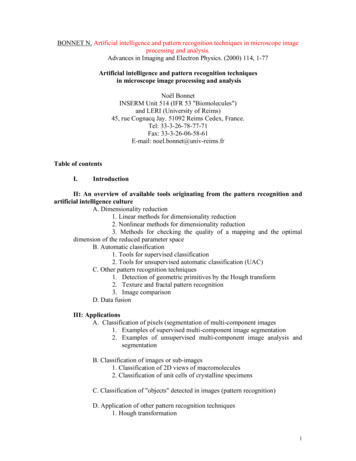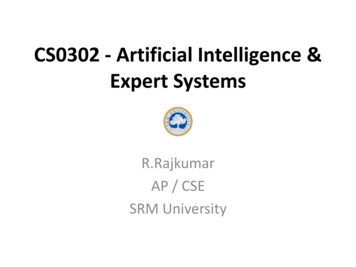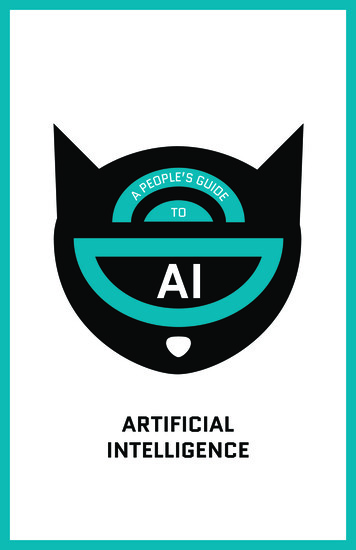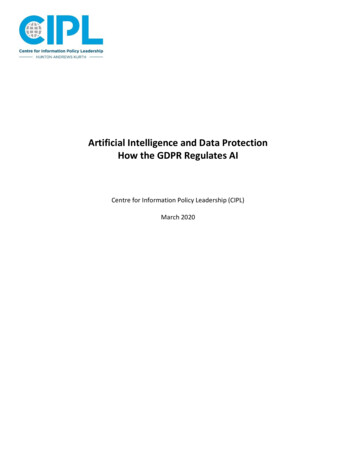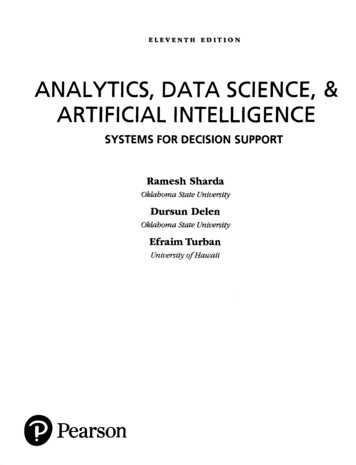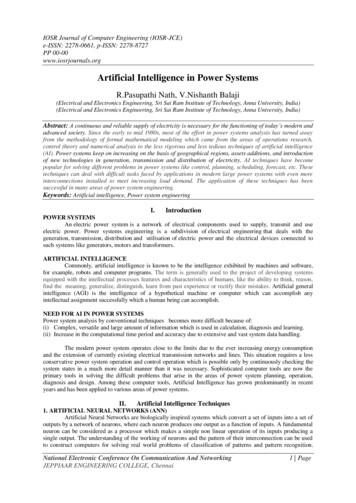
Transcription
IOSR Journal of Computer Engineering (IOSR-JCE)e-ISSN: 2278-0661, p-ISSN: 2278-8727PP 00-00www.iosrjournals.orgArtificial Intelligence in Power SystemsR.Pasupathi Nath, V.Nishanth Balaji(Electrical and Electronics Engineering, Sri Sai Ram Institute of Technology, Anna University, India)(Electrical and Electronics Engineering, Sri Sai Ram Institute of Technology, Anna University, India)Abstract: A continuous and reliable supply of electricity is necessary for the functioning of today’s modern andadvanced society. Since the early to mid 1980s, most of the effort in power systems analysis has turned awayfrom the methodology of formal mathematical modeling which came from the areas of operations research,control theory and numerical analysis to the less rigorous and less tedious techniques of artificial intelligence(AI). Power systems keep on increasing on the basis of geographical regions, assets additions, and introductionof new technologies in generation, transmission and distribution of electricity. AI techniques have becomepopular for solving different problems in power systems like control, planning, scheduling, forecast, etc. Thesetechniques can deal with difficult tasks faced by applications in modern large power systems with even moreinterconnections installed to meet increasing load demand. The application of these techniques has beensuccessful in many areas of power system engineering.Keywords: Artificial intelligence, Power system engineeringI.IntroductionPOWER SYSTEMSAn electric power system is a network of electrical components used to supply, transmit and useelectric power. Power systems engineering is a subdivision of electrical engineering that deals with thegeneration, transmission, distribution and utilisation of electric power and the electrical devices connected tosuch systems like generators, motors and transformers.ARTIFICIAL INTELLIGENCECommonly, artificial intelligence is known to be the intelligence exhibited by machines and software,for example, robots and computer programs. The term is generally used to the project of developing systemsequipped with the intellectual processes features and characteristics of humans, like the ability to think, reason,find the meaning, generalize, distinguish, learn from past experience or rectify their mistakes. Artificial generalintelligence (AGI) is the intelligence of a hypothetical machine or computer which can accomplish anyintellectual assignment successfully which a human being can accomplish.NEED FOR AI IN POWER SYSTEMSPower system analysis by conventional techniques becomes more difficult because of:(i) Complex, versatile and large amount of information which is used in calculation, diagnosis and learning.(ii) Increase in the computational time period and accuracy due to extensive and vast system data handling.The modern power system operates close to the limits due to the ever increasing energy consumptionand the extension of currently existing electrical transmission networks and lines. This situation requires a lessconservative power system operation and control operation which is possible only by continuously checking thesystem states in a much more detail manner than it was necessary. Sophisticated computer tools are now theprimary tools in solving the difficult problems that arise in the areas of power system planning, operation,diagnosis and design. Among these computer tools, Artificial Intelligence has grown predominantly in recentyears and has been applied to various areas of power systems.II.Artificial Intelligence Techniques1. ARTIFICIAL NEURAL NETWORKS (ANN)Artificial Neural Networks are biologically inspired systems which convert a set of inputs into a set ofoutputs by a network of neurons, where each neuron produces one output as a function of inputs. A fundamentalneuron can be considered as a processor which makes a simple non linear operation of its inputs producing asingle output. The understanding of the working of neurons and the pattern of their interconnection can be usedto construct computers for solving real world problems of classification of patterns and pattern recognition.National Electronic Conference On Communication And NetworkingJEPPIAAR ENGINEERING COLLEGE, Chennai1 Page
Artificial Intelligence in Power SystemsThey are classified by their architecture: number of layers and topology: connectivity pattern, feedforward orrecurrent.Input Layer: The nodes are input units which do not process the data and information but distribute thisdata and information to other units.Hidden Layers: The nodes are hidden units that are not directly evident and visible. They provide thenetworks the ability to map or classify the nonlinear problems.Output Layer: The nodes are output units, which encode possible values to be allocated to the case underconsideration.Architecture of a feedforward ANNTypical structure of an ANN1.1. Advantages:(i) Speed of processing.(ii) They do not need any appropriate knowledge of the system model.(iii) They have the ability to handle situations of incomplete data and information, corrupt data.(iv) They are fault tolerant.(v) ANNs are fast and robust. They possess learning ability and adapt to the data.(vi) They have the capability to generalize.1.2. Disadvantages:(i) Large dimensionality.(ii) Results are always generated even if the input data are unreasonable.(iii) They are not scalable i.e. once an ANN is trained to do certain task, it is difficult to extend for other taskswithout retraining the neural network.1.3. Applications:Power system problems concerning encoding of an unspecified non-linear function are appropriate forANNs. ANNs can be particularly useful for problems which require quick results, like those in real timeoperation. This is because of their ability to quickly generate results after obtaining a set of inputs.1.4. How ANNs can be used in power systems:As ANNs operate on biological instincts and perform biological evaluation of real world problems, theproblems in generation, transmission and distribution of electricity can be fed to the ANNs so that a suitablesolution can be obtained. Given the constraints of a practical transmission and distribution system, the exactvalues of parameters can be determined. For example, the value of inductance, capacitance and resistance in atransmission line can be numerically calculated by ANNs taking in various factors like environmental factors,unbalancing conditions, and other possible problems. Also the values of resistance, capacitance and inductanceof a transmission line can be given as inputs and a combined, normalized value of the parameters can beobtained. In this way skin effect and proximity effect can be reduced to a certain extent.2. FUZZY LOGICFuzzy logic or Fuzzy systems are logical systems for standardisation and formalisation of approximatereasoning. It is similar to human decision making with an ability to produce exact and accurate solutions fromcertain or even approximate information and data. The reasoning in fuzzy logic is similar to human reasoning.Fuzzy logic is the way like which human brain works, and we can use this technology in machines so that theycan perform somewhat like humans. Fuzzification provides superior expressive power, higher generality and animproved capability to model complex problems at low or moderate solution cost. Fuzzy logic allows aparticular level of ambiguity throughout an analysis. Because this ambiguity can specify available informationNational Electronic Conference On Communication And NetworkingJEPPIAAR ENGINEERING COLLEGE, Chennai2 Page
Artificial Intelligence in Power Systemsand minimise problem complexity, fuzzy logic is useful in many applications. For power systems, fuzzy logic issuitable for applications in many areas where the available information involves uncertainty. For example, aproblem might involve logical reasoning, but can be applied to numerical, other than symbolic inputs andoutputs. Fuzzy logic provide the conversions from numerical to symbolic inputs, and back again for the outputs.Benefits of using fuzzy logic2.1. Fuzzy Logic ControllerSimply put, it is a fuzzy code designed to control something, generally mechanical input. They can bein software or hardware mode and can be used in anything from small circuits to large mainframes. Adaptivefuzzy controllers learn to control complex process much similar to as we do.2.2. Applications:(i) Stability analysis and enhancement(ii) Power system control(iii) Fault diagnosis(iv) Security assessment(v) Load forecasting(vi) Reactive power planning and its control(vii) State estimation2.3. Reactive Power and Voltage ControlMain types of voltage problems are:(i) Planning of system reactive power demands and control facilities.(ii) Installation of reactive power control resources.(iii) The operation of existing voltage resources and control device.For reactive power control with the objective of enhancing the voltage profile of power system, fuzzylogic has been applied. The voltage deviation and controlling variables are converted into fuzzy set or fuzzysystem notations to construct the relations between voltage deviation and controlling ability of the controllingdevice. The main control variables are generator excitation, transformer taps and VAR compensators. A fuzzysystem is formed to select these control variables and their movement.National Electronic Conference On Communication And NetworkingJEPPIAAR ENGINEERING COLLEGE, Chennai3 Page
Artificial Intelligence in Power SystemsThe control variables are selected on the basis of:(i) Local controllability towards a bus having unacceptable voltage.(ii) Overall controllability towards the buses having poor voltage profile.2.4. How fuzzy logic can be used in power systems:Fuzzy logic can be used for designing the physical components of power systems. They can be used inanything from small circuits to large mainframes. They can be used to increase the efficiency of the componentsused in power systems. As most of the data used in power system analysis are approximate values andassumptions, fuzzy logic can be of great use to derive a stable, exact and ambiguity-free output.3. EXPERT SYSTEMSAn expert system obtains the knowledge of a human expert in a narrow specified domain into amachine implementable form. Expert systems are computer programs which have proficiency and competencein a particular field. This knowledge is generally stored separately from the program’s procedural part and maybe stored in one of the many forms, like rules, decision trees, models, and frames. They are also called asknowledge based systems or rule based systems. Expert systems use the interface mechanism and knowledge tosolve problems which cannot be or difficult to be solved by human skill and intellect.Structure of an Expert System3.1. Advantages:(i) It is permanent and consistent.(ii) It can be easily documented.(iii) It can be easily transferred or reproduced.3.2. Disadvantage:Expert Systems are unable to learn or adapt to new problems or situations.3.3. Applications:Many areas of applications in power systems match the abilities of expert systems like decisionmaking, archiving knowledge, and solving problems by reasoning, heuristics and judgment. Expert systems areespecially useful for these problems when a large amount of data and information must be processed in a shortperiod of time.3.4. How expert systems can be used in power systems:Since expert systems are basically computer programs, the process of writing codes for these programsis simpler than actually calculating and estimating the value of parameters used in generation, transmission anddistribution. Any modifications even after design can be easily done because they are computer programs.Virtually, estimation of these values can be done and further research for increasing the efficiency of the processcan be also performed.4. GENETIC ALGORITHMS (GA)Genetic algorithm is an optimization technique based on the study of natural selection and naturalgenetics. Its basic principle is that the fittest individual of a population has the highest probability and possibilityfor survival. Genetic algorithm gives a global technique based on biological metaphors. The Genetic algorithmcan be differentiated from other optimization methods by:(i) Genetic algorithm works on the coding of the variables set instead of the actual variables.(ii) Genetic algorithm looks for optimal points through a population of possible solution points, and not a singlepoint.National Electronic Conference On Communication And NetworkingJEPPIAAR ENGINEERING COLLEGE, Chennai4 Page
Artificial Intelligence in Power Systems(iii) Genetic algorithm uses only objective function information.(iv) Genetic algorithm uses probability transition laws, not the deterministic laws.Genetic algorithm is derived from an elementary model of population genetics. It has following components:(i) Chromosomal representation of the variable describing an individual.(ii) An initial population of individuals.(iii) An evaluation function which plays the environment’s part, ranking the individuals in terms of their fitnesswhich is their ability to survive.(iv) Genetic operators which determine the configuration of a new population generated from the previous oneby a procedure.(v) Values for the parameters that the GA uses.4.1. Applications:Areas of applications in power systems include:(i) Planning – Wind turbine positioning, reactive power optimisation, network feeder routing, and capacitorplacement.(ii) Operation – Hydro-thermal plant coordination, maintenance scheduling, loss minimisation, loadmanagement, control of FACTS.(iii) Analysis – Harmonic distortion reduction, filter design, load frequency control, load flow.4.2. How genetic algorithms can be used in power systems:As genetic algorithms are based on the principle of survival of fittest, several methods for increasingthe efficiency of power system processes and increasing power output can be proposed. Out of these methods,using genetic algorithms, the best method which withstands all constraints can be selected as it is the bestmethod among the proposed methods (survival of fittest).III.Practical Application Of Ai Systems In Transmission LineConsider a practical transmission line. If any fault occurs in the transmission line, the fault detectordetects the fault and feeds it to the fuzzy system. Only three line currents are sufficient to implement thistechnique and the angular difference between fault and pre-fault current phasors are used as inputs to the fuzzysystem. The fuzzy system is used to obtain the crisp output of the fault type. Fuzzy systems can be generallyused for fault diagnosis.Artificial Neural Networks and Expert systems can be used to improve the performance of the line. Theenvironmental sensors sense the environmental and atmospheric conditions and give them as input to the expertsystems. The expert systems are computer programs written by knowledge engineers which provide the value ofline parameters to be deployed as the output. The ANNs are trained to change the values of line parameters overthe given ranges based on the environmental conditions. Training algorithm has to be given to ANN. Aftertraining is over, neural network is tested and the performance of updated trained neural network is evaluated. Ifperformance is not upto the desired level, some variations can be done like varying number of hidden layers,varying number of neurons in each layer. The processing speed is directly proportional to the number ofneurons. These networks take different neurons for different layers and different activation functions betweenNational Electronic Conference On Communication And NetworkingJEPPIAAR ENGINEERING COLLEGE, Chennai5 Page
Artificial Intelligence in Power Systemsinput and hidden layer and hidden and output layer to obtain the desired output. In this way the performance ofthe transmission line can be improved.IV.Comparison Of Ai Techniques In Power System ProtectionV.Current Application Of Ai In Power SystemsSeveral problems in power systems cannot be solved by conventional techniques are based on severalrequirements which may not feasible all the time. In these situations, artificial intelligence techniques are theobvious and the only option. Areas of application of AI in power systems are:(i) Operation of power system like unit commitment, hydro-thermal coordination, economic dispatch,congestion management, maintenance scheduling, state estimation, load and power flow.(ii) Planning of power system like generation expansion planning, power system reliability, transmissionexpansion planning, reactive power planning.(iii) Control of power system like voltage control, stability control, power flow control, load frequency control.(iv) Control of power plants like fuel cell power plant control, thermal power plant control.(v) Control of network like location, sizing and control of FACTS devices.(vi) Electricity markets like strategies for bidding, analysis of electricity markets.(vii) Automation of power system like restoration, management, fault diagnosis, network security.(viii)Applications of distribution system like planning and operation of distribution system, demand sideresponse and demand side management, operation and control of smart grids, network reconfiguration.(ix) Applications of distributed generation like distributed generation planning, solar photovoltaic power plantcontrol, wind turbine plant control and renewable energy resources.(x) Forecasting application like short term and long term load forecasting, electricity market forecasting, solarpower forecasting, wind power forecasting.VI.ConclusionThe main feature of power system design and planning is reliability, which was conventionallyevaluated using deterministic methods. Moreover, conventional techniques don’t fulfill the probabilistic essenceof power systems. This leads to increase in operating and maintenance costs. Plenty of research is performed toutilize the current interest AI for power system applications. A lot of research is yet to be performed to perceivefull advantages of this upcoming technology for improving the efficiency of electricity market investment,distributed control and monitoring, efficient system analysis, particularly power systems which use renewableenergy resources for operation.ReferencesBooks:[1]. WarwickK., Ekwue A. And Aggarwal R. (ed). Artificial intelligence techniques in power systems. The Institution of ElectricalEngineers, London, 1997National Electronic Conference On Communication And NetworkingJEPPIAAR ENGINEERING COLLEGE, Chennai6 Page
Artificial Intelligence in Power SystemsJournal Papers:[2].[3].[4].International Journal of Engineering Intelligent Systems, The special issue on AI applications to power system protection, edited byM.M. Saha and B.Kasztenny, Vol.5, No.4, December 1997, pp.185-93.Dahhaghchi, I.,Christie, R.D, AI application areas in power systems, IEEE Expert,' Vol. 12, Issue 1 pages 58-66, Jan/Feb 1997Anis Ibrahim, W.R.; Morcos, M.M, Artificial intelligence and advanced mathematical tools for power quality applications: asurvey, Power Delivery, IEEE Transactions, Vol. 17, Issue 2, Pages 668-673, April 2002.Theses:[5].[6].[7].Khedher M.Z., Fuzzy Logic in Power Engineering,, Regional Conference of CIGRE committees in Arab Countries, May 25-27(1997), Doha, Qatar.Bachmann B., Novosel D., Hart D., Hu Y., Saha M.M., Application of artificial neural networks for series compensated lineprotection, Proc. of the Int. Conf. on Intelligent System Application to Power Systems, Orlando, January 28 - February 2, 1996,pp.68-73.Kirkpatrick S., Gelatt C. D., Vecchi M. P., 1983, "Optimization by simulated annealing". Science. New Series 220, pp.671–680.Lai, Loi Lei, 1998, Intelligent system applications in power engineering: evolutionary programming and neural networks, JohnWilley & Sons, UK.Proceedings Papers:[8].[9].[10].[11].B. Kosko, Neural Networks and Fuzzy Systems, Prentice Hall, Englewood Cliffs, NJ, U.S.A., 1992.Alander J. T., 1996, An indexed bibliography of genetic algorithm in power engineering, Power Report Series 94-1.El-Hawary, Mohamed E., 1998, Electric power applications of fuzzy systems, John Wiley USA.Momoh James A., EL-Hawary Mohamed E., 2000, Electric systems, dynamics, and stability with artificial intelligence, MarcelDekker, Inc. USA.National Electronic Conference On Communication And NetworkingJEPPIAAR ENGINEERING COLLEGE, Chennai7 Page
Power systems keep on increasing on the basis of geographical regions, assets additions, and introduction of new technologies in generation, transmission and distribution of electricity. AI techniques have become popular for solving different problems in power systems like control, planning, scheduling, forecast, etc. .
